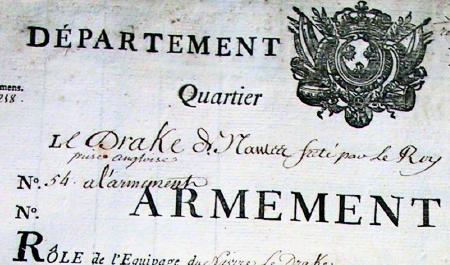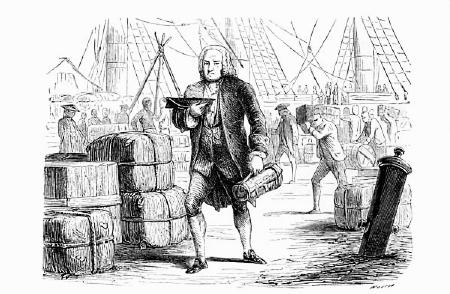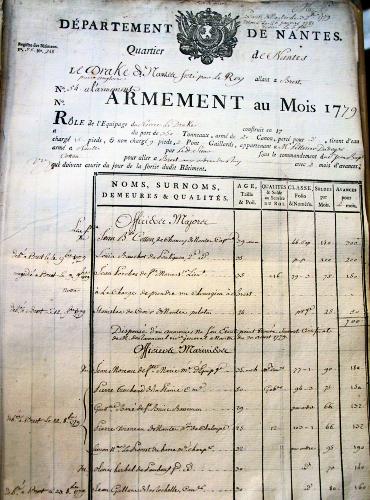| He Bought HMS Drake |
 FRENCH BUY PISCATAQUA PRIZE
FRENCH BUY PISCATAQUA PRIZE
A rare document in an email offers details on the first foreign warship captured by the American navy in foreign waters. HMS DRAKE was taken by John Paul Jones in 1778 in the Irish Sea aboard the Portsmouth-built ship RANGER. Despite a reluctant Piscataqua-area, Jones accomplished the impossible. Jean Peltier-Dudoyer, acquainted with Ben Franklin, bought the ship in 1779. (French version)
HMS Drake, built in1777, was the 12th British ship (out of 24) to bear that name. On April 24, 1778 the 20-gun warship Drake was captured by John Paul Jones off the British coast in a sunset battle lasting just over an hour. It’s commander George Burdon was mortally wounded in the battle. Jones and his reluctant crew from the Portsmouth, New Hampshire area outmaneuvered the British sloop in the Ranger, built at Kittery, Maine. This was the first time an American ship had defeated the "invincible" British navy in its home waters. The loss of Drake shocked the British military and its citizens. For the first time, the American Revolution came to English waters.
Despite a massive search by the British, Jones was able to elude the Royal Navy and deliver the Drake to port as a prize of war at Nantes in France. Jones hoped to trade its 200 crewmembers as prisoners of war. The Ranger and its crew returned , eventually, to Portsmouth and Jones returned to harass the British a year later in the Bonhomme Richard.

But what became of the Drake?
Tugdual Delanglais wrote to us from France to say that his great-great-grant-father Jean Peltier-Dudoyer, a shipowner of Nantes, purchased the "prise anglaise" or English prize. He offered us a rare picture of the sales document or "rôle d'équipage" from 1779.
According to Tugdual’s letter, his ancestor was active in equipping boats in the port of Nantes, fitting out ships from 1771 to 1786. Like John Paul Jones, Peltier was a freemason and initially became wealthy in the slave trade. Though part of the gentry, John Peltier (also Pelletier) sent his sons to good schools, was open to new ideas, and thought of French nobles as "leaches on society". After meeting Benjamin Frankin at Nantes in 1776, he worked to help the American cause, providing weapons to the revolution well before the French government joined the cause. He is mentioned a number of times in the letters of Benjamin Franklin. Peltier slipped the arms around his own government by following the old "triagnle trade" routs and shipping them via the West Indies.
By 1779, when he purchased the captured ship Drake, Jean Peltier-Dudoyer was the most successful shipping manager in Nantes. He lost 13 of his ships to the British and was involved in fitting out the Amphytrite, once promised to Jphn Paul Jones, and the Bonhomme Richard that Jones sailed to victory against the Serapis that same year. -- JDR

Painting of Ranger by William Gilkerson, used with permission.
HMS DRAKE SALE AT NANTES, FRANCH 1779

NOW READ THIS ARTICLE IN FRENCH (click below)
French Translation of Previous Web Page
John Paul JONES et le DRAKE
![]() Un document rare reçu par e-mail propose des détails sur le premier bateau de guerre étranger capturé par un navire américain dans des eaux étrangères. L’HMS Drake a été pris en 1778 dans la mer d’Irlande par John Paul Jones à bord du Ranger, bateau construit à Portsmouth. En dépit que Piscataqua soit une région difficile, Jones accomplit l’impossible. Jean Peltier-Dudoyer qui connaissait Benjamin Franklin, acheta le bateau en 1779.
Un document rare reçu par e-mail propose des détails sur le premier bateau de guerre étranger capturé par un navire américain dans des eaux étrangères. L’HMS Drake a été pris en 1778 dans la mer d’Irlande par John Paul Jones à bord du Ranger, bateau construit à Portsmouth. En dépit que Piscataqua soit une région difficile, Jones accomplit l’impossible. Jean Peltier-Dudoyer qui connaissait Benjamin Franklin, acheta le bateau en 1779.
L’HMS Drake, construit en 1777, était le douzième bateau britannique (sur 24) à porter le nom. Le 24 avril 1774, le bateau de guerre Drake, armé de 20 canons, était capturé par John Paul Jones, au large des cotes britanniques au coucher du soleil, au cours d’un combat qui dura juste un peu plus d’une heure. Georges Burdon qui le commandait était mortellement blessé dans le combat. Jones et son équipage rebelle de Portsmouth, de la région du New-Hampshire, amarina le sloop britannique, construit à Kittery dans le Maine, le long du Ranger. C’était la première fois qu’un bateau américain infligeait une défaite à « l’invincible » marine britannique dans ses propres eaux. La perte du Drake bouleversa les militaires britanniques et les citoyens. Pour la première fois la Révolution américaine pénétrait dans les eaux anglaises.
En dépit d’une recherche massive par les Anglais, Jones a été capable d’éviter la Royal Navy et de ramener le Drake au port de Brest en France comme prise de guerre. Jones espérait négocier les 200 membres d’équipages comme prisonnier de guerre. Le Ranger et son équipage retournant finalement à Portsmouth et Jones repartnant pour harceler les Britanniques une année plus tard avec le Bonhomme Richard.
Mais qu’est devenu le Drake ?
Tugdual de Langlais nous écrit de Bretagne (France) pour nous dire que son arrière-arrière-grand-père Jean Peltier-Dudoyer, un armateur de Nantes, a acquis la « prise anglaise ». Il nous a offert une rare représentation du « rôle d’Armement » de 1779, où figure l’équipage.
Tugdual de Langlais nous écrit de Bretagne (France) pour nous dire que son arrière-arrière-grand-père Jean Peltier-Dudoyer, un armateur de Nantes, a acquis la « ». Il nous a offert une rare représentation du « rôle d’Armement » de 1779, où figure l’équipage.
Selon la lettre de Tugdual de Langlais, son ancêtre était un important armateur du port de Nantes, armant 50 bateaux de 1771 à 1786. Comme John Paul Jones, Peltier était franc-maçon, et déjà enrichi dans le commerce des esclaves. Cependant comme le faisait la bourgeoisie, Jean Peltier (ou Pelletier) ouvert aux idées nouvelles, envoya ses fils dans de bonnes écoles, il pensait que la noblesse française était terminée. Après avoir rencontré Benjamin Franklin à Nantes en 1776, il travailla pour aider la cause américaine, approvisionnant en armes la Révolution américaine bien avant que le gouvernement français n’adhère à leur cause. Il est mentionné un certain nombre de fois dans les lettres de Benjamin Franklin. Peltier introduisit des armes en contournant son propre gouvernement en les embarquant pour les Indes Occidentales, rendu là-bas les navires débarquaient leurs marchandises qui étaient transbordées sur des caboteurs ou ils continuaient leur route jusqu’aux Etats-Unis.
En 1779, quand il a acheté la prise le Drake, Jean Peltier est un des plus important armateur de Nantes. Il perdit 13 de ses bateaux pris par les Britanniques et il était amené à armer l’Amphitrite, promis à John Paul Jones.
Translated from English by Tugdual Delanglais
